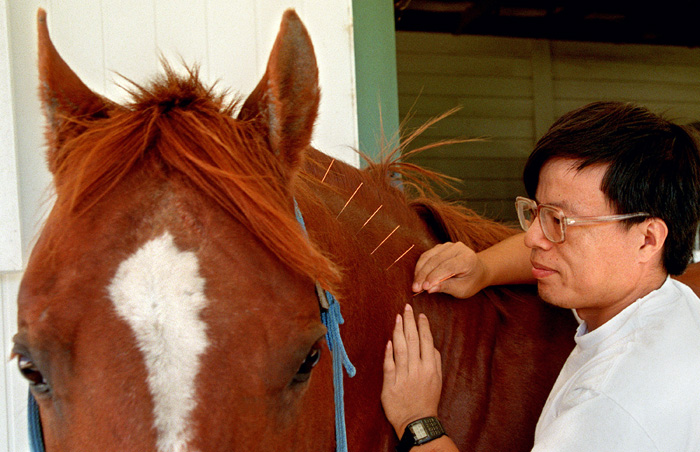
Since we call western medicine “conventional” medicine, it follows that Complementary and Alternative Medicine would be considered unconventional medicine. In recent years, more and more doctors and veterinarians are embracing alternative therapies as an adjunct to traditional treatment modalities. Though adoption has been gradual, as more practitioners and clients experience positive outcomes, they become advocates, even promoters. With increased interest and case loads, opportunities for research arise which, in turn, bring greater understanding and acceptance of the applications of various therapies.
Traditional Chinese Veterinary Medicine (TCVM) is based on the idea that the individual parts of the animal work in concert, and healing is best accomplished when the whole body system is brought into balance. Both eastern and western medicine rely on medical history and examination for diagnosis. While western practitioners may recommend surgery and pharmaceuticals, the TCVM practitioner may recommend acupuncture, herbs, or management changes. Ultimately, both eastern and western medicine have as their goals; promoting animal health and preventing disease.
The most widely known alternative therapy is acupuncture. In acupuncture, specific points on the body called acupoints are stimulated resulting in endorphin release, increased blood flow, improved immune function and blood pressure regulation. Stimulation of acupoints may be accomplished with tiny needles, pressure, low level electricity, warmth, laser, fluid, or air. Veterinary acupuncture is most commonly used for pain management, geriatric medicine, and sports medicine. A lesser known value of acupoints is their use in diagnostics. In the hands of a certified veterinarian, acupuncture can provide horses with chronic conditions much improved quality of life.
Herbal medicine is an integral component of TCVM, often used in conjunction with acupuncture. Most herb blends are developed for the specific needs of the individual based on the properties of the plants and actions in the body. Herbal medicine utilizes the whole plant or defined portions of a plant compared to a single, isolated active ingredient as in western pharmacology. There are risks associated with inappropriate use of herbs so erring on the side of caution and seeking expert advice is warranted.
Chiropractic care involves manipulations of joints of the spine to treat biomechanically related musculoskeletal disorders. It is particularly helpful as an adjunct treatment for lameness and is intended to correct vertebral alignment and restore full nervous function so the animal can heal.
Massage therapy for horses is similar to massage in humans. The therapist is not providing a diagnosis but rather providing relief of muscle tension and spasms. Massage therapy can improve muscle tone, increase range of motion, relieve pain and increase circulation for more rapid healing of injuries.
Tui-Na is a manual therapy that combines chiropractic and massage to prevent and treat disease. Manipulations applied to acu-points and meridians or limb-stretching movements are employed to soothe joints, promote circulation and strengthen the body’s resistance. These techniques are particularly effective in treatment of musculoskeletal conditions.
Energy medicine is based on the concept that life relies on energy and disease occurs when there is an imbalance of a bio-energetic field. Some types of energy used therapeutically are electric, magnetic, sonic, acoustic, microwave, and infrared.
Environmental medicine advocates improvement in the environmental conditions that are contributing to disease. Factors may include mold, dust, chemicals and certain foods. Heaves is a prime example of a disease in which environmental modifications might bring relief.
Nutrition and diet are another major component of holistic medicine (treating the whole animal rather that the disease). Classical nutritional requirements are based on the average of a whole population, not the individual. Additionally, certain types of feeds can serve to promote wellness and provide adjunct therapy for other forms of treatment. Nutraceuticals are nutritional supplements used as therapeutic agents.
Homeopathy is based on the concept of like heals like. Homeopathic remedies are extreme dilutions of substances that are known to cause disease symptoms. Conceptually, dilutions of these substances promote healing. Little research has been done in horses treated with homeopathy.
Alternative therapies are not intended to replace conventional medicine for diagnosis and treatment of acute conditions. The use of eastern medicine in concert with western medicine, however, enhances quality of life and provides a more whole-animal approach to health and well-being. Alternative and complementary medicine is becoming an integral part of veterinary training and is requested by an increasing number of horse owners.
 0
0
